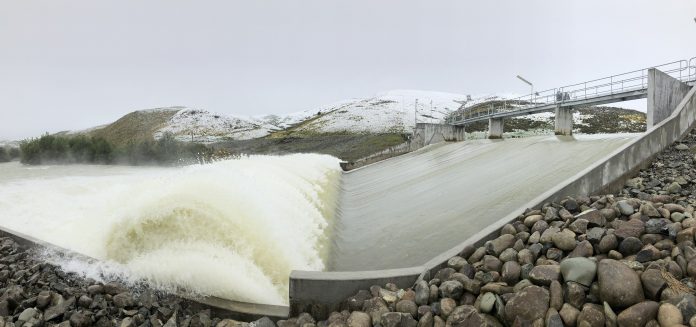

A day doesn’t go by where there isn’t an item in news media somewhere about more evidence of accelerating climate change and the impact that is likely to have on global food production sustainability.
Changes in weather patterns, in particular, and the impact that has on rainfall in food production areas — whether that be more floods and/or more droughts — are becoming a particular focus.
All of this makes the originators of the proposal to build a water storage dam on the Opuha River in South Canterbury 25 years ago this month seem even more innovative and prophetic than they were at the time.
Drought was the motivator for the dam’s construction, a successful effort to ensure consistent flows in the Opuha/ Opihi River while providing reliable irrigation to allow intensification and diversification in the shareholder farms.
Now, perhaps ironically, Opuha dam is having an increasing role in reducing the devastating impacts of floods in the catchment area.
In late May 2021, South Canterbury was hit by an ‘‘atmospheric river’’ that brought incredibly high rainfalls with substantial flooding in the lower Opihi River. When the rain hit, Lake Opuha rose by 11.84m over a 48-hour period, capturing 43 million cubic metres of water.
At the peak of the event the lake had inflows of 440 cubic metres per second (cumecs) but was only discharging about 14 cumecs into the Opuha/Opihi River system.
Had the dam not held back the high flows from its catchment, water levels in the lower reaches of the Opihi River system would have been even higher with substantially more community damage likely.
As we look to the future, Opuha Water Ltd has recognised the important role the dam will play in helping to protect not just farmland, but homes, businesses, water supply systems, roading infrastructure and flood protection works from high-impact flood events.
An important part of this planning will be to add gates with a higher flow regulation range to the main spillway. This will greatly extend the ability of the Opuha Dam to act as a buffer in major floods, protecting assets and the economy in the region.
Opuha Water will be seeking support from central and local government for these plans, recognising the value they will provide the wider community.
Of course, the original reasons for the construction of the Opuha Dam still apply. The ability of the dam to consistently supply water to the river catchment has benefited not just farmers in terms of irrigation, but water supply for Timaru, enabled the migration of introduced and native fish species, and helped maintain a continuous biodiverse river system from the mountains to the sea. The recreation values of the lake and enhanced river system have drawn people from throughout the region and beyond.
The value-add of the Opuha Dam to South Canterbury can be hard to measure. For example, how do we quantify the cultural and conservation values connected to ensuring, through controlled water releases, the natural breeding migration of tuna (eels) to and from the sea?
Not every benefit can easily be broken down into economic terms. That said, the value of the Opuha Dam to the South Canterbury economy has been considerable and is likely to increase as security of water supply and flood mitigation assume greater importance in our changing world.
The economic benefit of Opuha Dam to South Canterbury has not been officially quantified since 2006, but even then the figures were impressive: $124 million in output; $41m in value add; $20m to household incomes and nearly 500 extra jobs. The evidence since suggests these figures have only increased.
The Opuha Dam has been recognised as one of the best examples of a water storage project in the country. We owe a lot to those early thinkers and innovators who brought the dam to completion 25 years ago.
Our challenge now is how we future-proof the dam and the operation for a sustainable and beneficial future. There is opportunity for local, regional and national government, business and a new generation of entrepreneurs and investors to join us on that journey.




